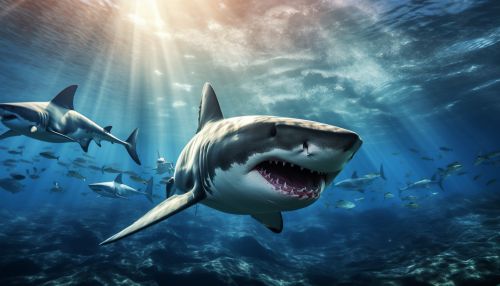Cetaceans
Introduction
Cetaceans are a group of aquatic mammals that includes whales, dolphins, and porpoises. They are part of the order Cetacea, which is derived from the Greek word "ketos," meaning "large sea creature." Cetaceans are characterized by their streamlined bodies, which are adapted for fast swimming, and their modified forelimbs, which have become flippers. They are also known for their highly developed auditory system, which they use for echolocation, a method of locating objects by reflecting sound.
Evolution
Cetaceans are thought to have evolved from land-dwelling mammals around 50 million years ago during the Eocene epoch. This transition from land to sea is one of the most significant evolutionary changes in the mammalian lineage. The earliest known cetacean is Pakicetus, a wolf-sized creature that lived in what is now Pakistan. It had features of both land mammals and modern cetaceans, suggesting it was a transitional species. Over time, cetaceans' bodies became more streamlined, their hind limbs disappeared, and their forelimbs became flippers, adaptations that allowed them to become efficient swimmers.


Anatomy and Physiology
Cetaceans have a number of unique anatomical and physiological features that distinguish them from other mammals. Their bodies are streamlined for efficient swimming, with a layer of blubber for insulation and buoyancy. Their nostrils have evolved into a blowhole located on top of their heads, allowing them to breathe while most of their body is submerged. Their tails have evolved into flukes, which they move up and down to propel themselves through the water.
Cetaceans also have a highly developed auditory system, which they use for echolocation. This involves emitting a series of clicks, then listening for the echoes to determine the location and distance of objects. This ability is particularly well developed in dolphins and toothed whales, which use it to locate prey and navigate their environment.
Behavior
Cetaceans exhibit a wide range of behaviors, many of which are complex and not fully understood. They are known for their acrobatic displays, such as breaching (jumping out of the water) and tail slapping. These behaviors are thought to serve various purposes, including communication, dislodging parasites, and stunning prey.
Many cetaceans are social animals, living in groups known as pods. Within these pods, individuals often form strong social bonds and exhibit cooperative behaviors, such as hunting together and caring for each other's young. Some species, like the killer whale, have complex social structures that include multiple generations and distinct cultural behaviors.
Conservation
Many cetacean species are threatened by human activities, including hunting, habitat degradation, and pollution. Whaling, in particular, has had a devastating impact on many whale populations. Despite international efforts to regulate whaling and protect cetacean species, many populations continue to decline.
Conservation efforts for cetaceans are complicated by the fact that these animals live in the open ocean, making them difficult to study and protect. However, advances in technology, such as satellite tagging and acoustic monitoring, are providing new insights into cetacean behavior and distribution, which can inform conservation strategies.
